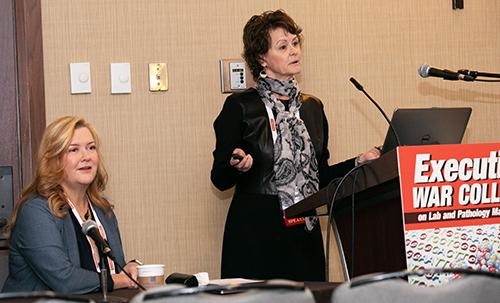Executive War College: Efficient Data Structure Can Bring in More Reimbursement Dollars and Allow Clinical Laboratories to Sell Aggregated Information
Speakers at this week’s Executive War College in San Antonio explained that the way records are collected and stored plays a large part in the long-term usefulness of clinical laboratory data
Data structure as a term may not flow off the lips of clinical laboratory and pathology laboratory managers, but it should be top-of-mind. Well-structured data improves reimbursements and, in aggregated form, can be an enticing avenue to partnerships with outside parties.
Data structure refers to the makeup of digital records—in other words, how data is collected, stored, and accessed. Structured information offers consistency and is easier to analyze and share.
However, data structure often is difficult to achieve for clinical laboratories, according to Patricia Goede, PhD, Vice President, Clinical Informatics, at XIFIN, Inc. She spoke Tuesday during this year’s Executive War College Conference on Laboratory and Pathology Management in San Antonio. The conference concludes today.
“You have to make sense of all that messy data, and that’s a heavy lift,” she said. “Results are not standardized.”
Appeals Payments Increase with More Clinical Data
Data quality can improve claim reimbursement appeals, Goede noted. When a more complete clinical record is provided to payors, they are more likely to reimburse for services.
According to information Goede covered along with Julie Ramage, Director of Precision Medicine Quality Initiatives and Partnerships at biopharmaceutical company AstraZeneca, when appealing a denied claim for a colon cancer molecular test, for example, the average appeal payment was $318 without cross-specialist clinical records.
Meanwhile, payment for a similar claim appeal which included that added data jumped to $612!
Goede and Ramage shared their knowledge and experiences during their EWC presentation, “New Ways to Add Value! What Innovative Labs and Collaborating Physician Groups Are Doing Today to Provide Aggregated Data Sets to Big Pharma, Bioresearch, and Oncology Centers.”
Structured data that ties in information from the ordering physician helps increase those appeal payments, Goede said, citing research published in the Journal of Clinical Oncology, titled, “Laboratory and Clinical Data Integration: Toward an Evidence Development Framework.”
Other useful clinical data for reimbursement appeals include:
- Demographics,
- Medical history,
- Patient family history,
- Prior clinical laboratory test results, and
- Predicted impact of medical treatment.
This information is often available, but may not be structured in a way that makes it easy to share with a payer. “You really have to be thinking about what elements you need,” Goede said.
Market for Structured, Anonymized Lab Data
Clinical laboratories that want to provide or sell anonymized, aggregated data to outside parties—such as research firms or pharmaceutical companies—also need to pursue efficient data structure. The re-use of existing, high-quality lab data can create a new business revenue stream.
“But it has to be more than that vanilla, male/female, date-of-birth stuff,” Ramage noted.
For example, she said, genetic testing builds up data registries, and that’s what pharma is looking for to find patients early on.
“If you don’t have a way to structure your data, you’re not going to be able to play in the sandbox,” she added.

Co-presenters Julie Ramage (left), Director of Precision Medicine Quality Initiatives and Partnerships at AstraZeneca Pharmaceuticals, and Patricia Goede, PhD (right), Vice President of Clinical Informatics at XIFIN, Inc., answer attendee questions about data structure during their presentation at this week’s Executive War College Conference on Laboratory and Pathology Management in San Antonio. To register for EWC 2022 and receive a special early-bird rate, click here by November 6.
How Clinical Laboratories Can Improve Clinical Data Structure
Here are some tips for clinical laboratory executives to consider as they tackle data structure:
- Standardize how to enter patient information and test results. A common problem with data input is that the same information is entered differently over time. For example, various patient records might refer to dates in different ways: November 1, 2021, can also be entered as 11/1/21, 11/1/2021, or 11-01-21. Structured data uses a single way to list dates in records. This lesson applies to all similar clinical data.
- Use dropdown menu choices instead of free-typing, open fields. An online box to enter a test result can create a variety of entries that affect data structure. While not perfect, drop-down options create a consistent set of entries, Goede said.
- Ask patient advocacy groups about common nomenclature. Clinical laboratory data should reflect how patients speak, Ramage said. For example, do patients refer to genomic and genetic testing as the same thing? Establishing more consistency improves data structure as records are updated.
- Enlist your organization’s IT or research team for help. Tech workers and principal investigators can easily look at clinical laboratory data and tell what information is missing or inconsistent, said Cheryl Schleicher, Director of IT Strategy at Northwell Health Labs in Lake Success, NY. Schleicher attended this week’s Executive War College.
Look Further into Clinical Laboratory Data Structure
Data structure can help clinical laboratories and pathology laboratories grab more reimbursement dollars and potentially sell anonymized data to external partners.
It is an area many lab executives are not familiar with and need to investigate more, particularly following the accelerated move to digital lab services during the COVID-19 pandemic. Your organization’s IT department or Chief Information Officer can be a useful ally.
If you could not make it to this week’s Executive War College, then join us for our next Executive War College on April 27-28, 2022, in New Orleans. Click here to take advantage of special early-bird pricing for this critical event.
—Scott Wallask
Related Information:
PAMA Price Reporting Update: What to Watch for During Data Validation



